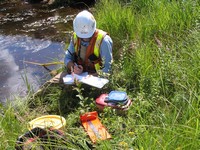 Minimizing the footprint of Xstrata Nickel’s new copper/nickel mine in the Sudbury Basin has been at the forefront of the company’s sustainable development plan.
Minimizing the footprint of Xstrata Nickel’s new copper/nickel mine in the Sudbury Basin has been at the forefront of the company’s sustainable development plan.
As Xstrata’s first new mine in the area to be brought on line in 19 years, opportunities existed to incorporate new engineering and environmental best practices. Additionally, Xstrata wanted to be a good corporate citizen to surrounding communities and First Nation groups.
The property was purchased in the ‘60s for exploration, but it wasn’t until 2001 that high-grade nickel and copper ore was discovered. Now, the mine is in the commissioning phase and is expected to provide a high value ore feed for more than 15 years.
The mine is located in the “backyard” of two Sudbury-area communities: Skead and the Wahnapitae First Nation reserve. It is situated between two watersheds, the Massey Creek watershed, east of the site, and the Nickel Rim Creek. Both creeks flow into nearby Lake Wahnapitae. Consequently, there was a lot of interest in how Xstrata was going to develop the site, said Chad Pearson, area leader for health, safety, environment and community.
“There was some sensitivity at the beginning about how we were going to do this project,” he said. “We did a number of risk assessments relating to noise and water contamination, then put things in place to mitigate those risks.”
It was decided to pave the entire site in order to collect the storm water runoff. Three holding ponds collect both surface and underground water. The first one acts as a sludge settling pond. Collected water will then flow into a retention pond, followed by a gravity pipeline into another retention pond from which it is pumped through a 15-kilometre underground pipeline to the smelter’s regulated wastewater treatment plant.
The mine’s underground dewatering system collects water throughout the working levels. It flows by gravity to the bottom of the shaft. From there, sump pumps send the water up by pipe into the holding ponds on surface.
The absence of an effluent discharge point on site not only reduces the risk of contamination, but also minimizes the footprint, Pearson said.
All the roads into the site have also been paved, reducing the amount of dust generated.
Ground and surface water in the creeks are monitored quarterly for water quality, flow measurements, general chemistry, conductivity and pH. Metal analyses are also performed. Underground air quality is monitored frequently, particularly after blasting, said Pearson.
Additional efforts were made to minimize noise from the two ventilation exhaust fans. Noise silencers were installed to reduce the amount of noise generated by the exhaust fans for nearby cottagers and Skead residents.
“We set stringent internal targets for the project to reduce the amount of noise being released off the site,” Pearson said. “We spent a lot of money developing, engineering and installing these silencers.”
Noise
The Hatch-MacIntosh alliance, which was awarded the engineering and construction contract for the mine, brought in experts on noise and vibration to mitigate it as an environmental risk.
Pearson said the silencers reduced the noise to “almost half of the limit at the nearest receptor,” based on accepted Ministry of Environment standards.
Additionally, a condensate, or drop out chamber, was placed on the ventilation exhausts to collect water vapour. This water will also be sent to the holding pond and on to the wastewater treatment facility.
“Many of those initiatives weren’t mandated, but put in place to reduce the risks to the environment and community, as well as potential complaints,” Pearson said.
Rehabilitation of the historic liability that accompanied the Nickel Rim North Mine, a former producer during the ‘50s, has been another project Xstrata Nickel has been working on to improve water quality in the area.
“We installed engineered dams to capture water from that area, and from there it gets sent to the smelter through the same pumping system,” Pearson said. “There has been a huge improvement in the water quality proven through aquatic environmental assessments.”
The company plans to blend the historic tailings with the Nickel Rim South tailings as hydraulic fill for the stopes at the new mine.
Transparency and communication with the surrounding communities were initiated prior to groundbreaking. Open houses and meetings allowed concerns to be voiced and dealt with. Biannual newsletters update local residents about the project’s progress.
“We have an open line for anyone who has concerns,” Pearson said. “Our goal is to be a good corporate citizen, not a bully.”
First Nation
Talks with Wahnapitae First Nation members led to the signing of a participation agreement June 19, 2008. The agreement provides a framework focused on environmental protection, education and training, and community development. An annual contribution for the aforementioned will be made and investments decided upon by an implementation committee made up of representatives from both parties.
Since a large portion of the agreement revolves around the protection of the environment, a First Nation environmental co-ordinator is funded to assist with environmental monitoring and related activities.
Other company contributions were made to help purchase a new roof for the Skead senior citizens building and to fund the Skead community centre and its volunteer committee. Project team members also donate time and supplies to assist with the community’s spring cleanup.
A biodiversity plan to maintain a variety of plant and animal species was also presented to interested parties as part of the company’s sustainable development plan.


